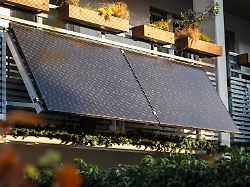New systems at record levels
Balcony power plants are making the solar industry boom
January 2, 2024, 7:30 a.m
Listen to article
This audio version was artificially generated. More info | Send feedback
Germany has long been a pioneer in solar energy, but then loses touch internationally. The demand is enormous. In 2023, more systems will come online than ever before. Balcony power plants in particular are very popular. The success story should continue in 2024.
According to the solar industry, more new solar systems to generate electricity and heat were built in Germany last year than ever before. More than a million new systems have been installed, reported the Federal Solar Industry Association (BSW) in Berlin.
The so-called balcony power plants play a large part in this. Around 270,000 plug-in solar devices were put into operation in Germany in 2023. That is four times as many as in 2022. According to the Federal Network Agency, systems with a peak output of around 14 gigawatts have been put into operation on roofs and open spaces, the association also reported. This is 85 percent more than in the previous year 2022.
Half of the newly installed solar power output in 2023 was in the home segment, according to the BSW. PV systems on open spaces accounted for around 31 percent, and PV systems on commercial roofs accounted for around 18 percent. “Due to their low specific output, the large number of plug-in solar devices did not account for two percent of the newly installed PV output,” emphasized BSW Managing Director Carsten Körnig.
Twelve percent of the energy comes from solar power
There are now around 3.7 million solar power systems installed in Germany. They would have generated around 62 billion kilowatt hours of electricity in 2023, covering around 12 percent of German electricity consumption.
The industry association expects demand to remain high in 2024. He justifies this with continued rising electricity prices and attractive funding conditions. “We expect a sustained solar boom in 2024,” explained Körnig. In order for the growth targets to be achieved in the following years, the reduction in bureaucracy must not come to a standstill. Further measures to speed up the process are required in order to upgrade the electricity and heating networks more quickly.
Specifically, in the home segment with roof systems with a PV output of up to 30 kilowatts, the association expects demand in 2024 to be of a similar magnitude to 2023. Last year, PV roof systems with a total of seven gigawatts of peak output were installed in this segment. However, the BSW expects market growth for PV systems on commercial roofs and open spaces.
